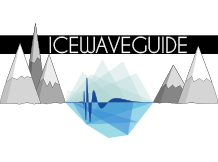Documentary of the experiment
Please check the documentary about the Icewaveguide expedition, Le Requiem de la Banquise
Be ready for exciting science and stunning images of the beauty of Svalbard, right when the polar night comes to an end.
Scientific context of the experiment
The decline of Arctic sea ice extent is one of the most spectacular signatures of global warming, and studies converge to show that this decline has been accelerating over the last 4 decades, with a rate that was not anticipated by forecasting models (Stroeve et al., 2012). This is a major concern in environmental sciences because the extent of sea ice influences climate in the rest of the globe and is associated with large climate patterns such as the North Atlantic Oscillation and Atlantic Multidecadal Oscillation.
In order to improve forecasting models, relying on comprehensive and accurate field data is essential. While sea ice extent and concentration have been accurately monitored for decades from microwave imagery, we are still lacking an accurate and comprehensive measure of its thickness. In addition, models could benefit from including other observables related to the ability of the ice cover to resist cracking and to heal/reform when cracking occurs. This type of resilience is obviously related to the thickness of the ice layer, and in this matter measures are provided mainly via radar, electromagnetic, and sonar approaches (Haas et al., 2010 ; Lindsay and Schweiger, 2015), each having their strengths and weaknesses in terms of accuracy and practical implementation. On the other hand, quantifying other important parameters such as the mechanical resistance and level of damage (cracking) of the ice cover (Danserau et al., 2016) still requires additional effort. Because these could prove to be essential in future forecasting models (Proc. Int. Workshop Arctic sea ice thickness, past, present & future, 2005), the development of new, complementary approaches able to simultaneously assess these parameters is desirable.
Moreover, our understanding of how the sea ice cover deforms is still limited by the lack of observation of cracking/slips events along the leads. The latter are typically imaged by satellite monitoring, sometimes extending over the whole Arctic basin, but at a time scale (typically a few days) that prevents the study of the dynamical process leading to their deformation (e.g., Stern and Moritz, 2002 ; Kwok and Sulsky, 2010). Alternatively, buoy drifts give better temporal resolution, but with sparse coverage (e.g., Rampal et al., 2009). So far, the kinematical description of this deformation has thus been performed mostly with continuous approaches, typical of fluid mechanics, which naturally arise when summing over many individual deformation events (Colony and Thorndike, 1985 ; Marsan and Weiss, 2010). In situ seismic monitoring of individual deformation episodes is therefore critical for our understanding of the mechanical response of the ice cover to the environmental forcing. The development of seismic methods designed to characterize deformation transients and changes in the cover (i.e., damage level) occurring in the far-field is therefore of great interest. Given the hostile environment and the logistic constraints specific to the Arctic domain, smaller-scale experiments can help to assess and to develop such methods to a lesser cost prior to large-scale measurements campaign.
This research project aims at proving the concept of an original methodology, based on the measure of seismic waves guided in the ice, for estimating several observables related to sea ice resilience : thickness, mechanical properties, and damage level (cracking).
News
Icewaveguide expedition to Svalbard : listening to the murmurs of the Arctic sea ice
Will the murmurs of the sea ice allow us to better (...)



